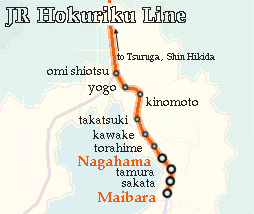where you are:SSG Home/the guide/transportation/regular trains/JR Hokuriku Line
|

All trains on the Hokuriku Line are Futsu (local) trains.
The following are tips from a helpful JET for surviving travel on the Hokuriku Line (Lisa Robertson--Makino-cho, 1997-8)
The trains bound for either Maibara or Imazu all have to stop in Omi-shiotsu. They also all have to pull in and out on the same track, meaning that the train will turn around at Omi-shiotsu and leave the station facing the opposite direction. This may seem alarming at first, but if you are sure that the train is stopping at your destination (because you asked your friendly JR employee) then there is no problem. Sometimes you have to change trains (and platforms) at Omi-shiotsu, and other times you don't. You can tell for sure by reading the schedule carefully, or by getting someone to help you (for tips and instructions on how to do this, head here).
The trains often wait at the station for a long time before continuing on to their destinations. This is, of course, no problem if you can understand the conductor's announcements, but if you can't, it can be a bit alarming if you wander off the train to buy a soda and return to find it's gone. So I would just recommend that people ask the conductors if they're not sure what is going on. I often notice that the Japanese are quite confused by the mysterious system used on this route, so the employees are probably expecting foreigners to have questions as well.
The last thing is that the doors don't open automatically from the first of December to the last day of March because it's so cold...there's a sign to this effect on the doors. You can pull them open (they open inwards) after the train comes to a complete stop. By the way, the same thing holds true for the Kosei Line trains during the same period--a little known gem of western lake lore. One more hint--the trains running between Imazu and Maibara and vice-versa are always a certain type (white with a blue racing stripe-joke!) and say "Town Train" on the front. I think "train" is in Katakana, but "town" is definately in Romaji. |
|
The Hokuriku Line services the northeastern part of Shiga. Technically, it is connected to the Biwako Line at Maibara Station, although many trains travelling the Biwako Line either originate from, or make their final destination at, Nagahama Station. The Hokuriku Line is connected to the Kosei Line in the north at Omi Shiotsu Station. The only Shinkaisoku stop on the line is at Maibara Station. All Shinkaisoku trains become Futsu trains between Maibara and Nagahama. When traveling from Maibara, the final destinations are Nagahama, Kinomoto and Omi Shiotsu Stations.
|
| STATIONS ON THE HOKURIKU LINE |
 |
Maibara
(Transfer for the Biwako Line) |
 |
Sakata |
 |
Tamura |
 |
Nagahama
(In many cases, transfer for the Biwako Line can also be done here) |
 |
Torahime |
 |
Kawake |
 |
Takatsuki |
 |
Kinomoto |
 |
Yogo |
 |
Omi Shiotsu
(Transfer for the Kosei Line) |
 |
Shin Hikida |
 |
Tsuruga |
|
|
|
|
|
|
|

